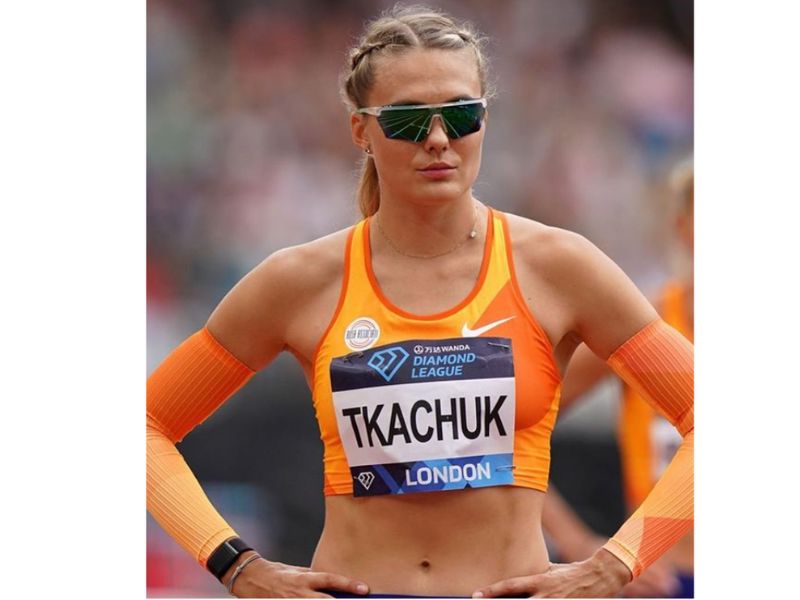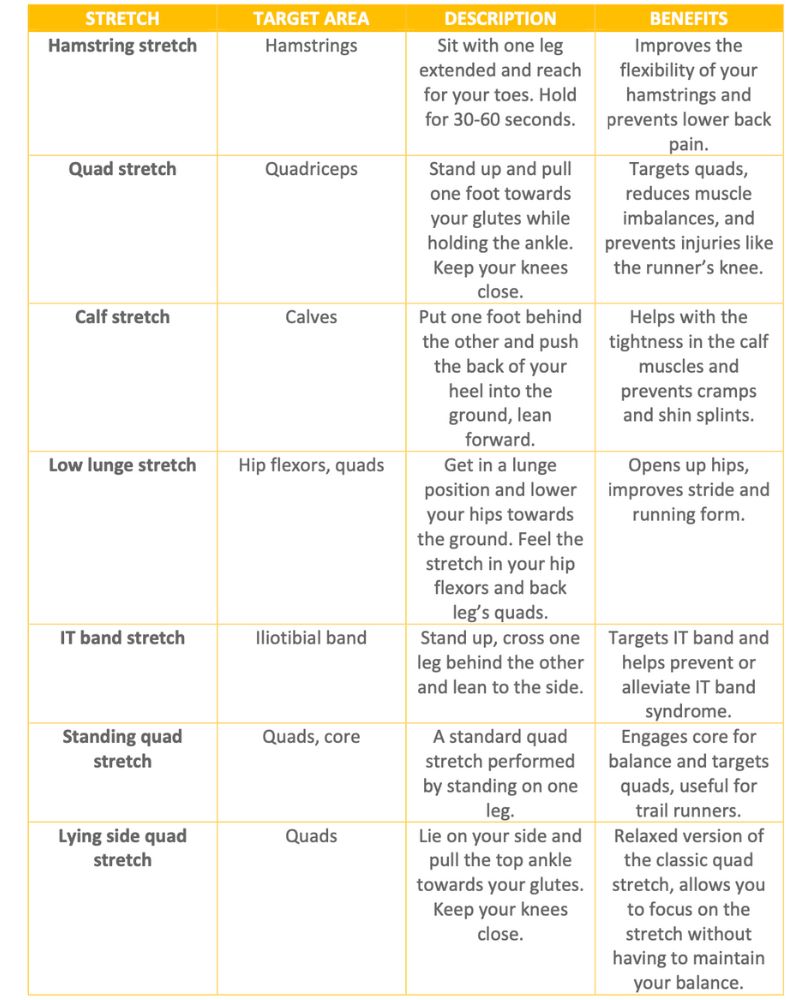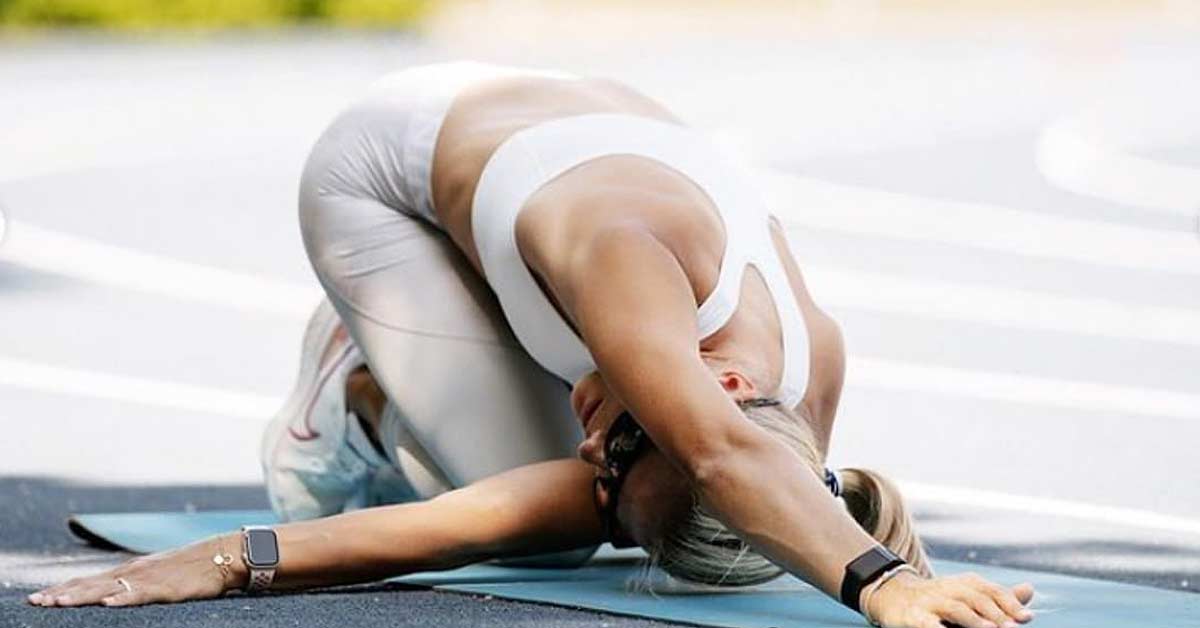There are two types of stretches involved in running: dynamic (usually done pre-running) and static (usually performed post-running). Here, we’ll focus on the best post-run stretches you can do to enhance your muscle recovery after training or competing.
To start with, is post-run stretching even worth the extra time and effort? Yes, it definitely is.
Giving your muscles a good ol’ stretch after a hefty running session can be beneficial. As your muscles warm up, they become more flexible—stretching them right after running could prove beneficial for your range of motion, as well as accelerate your muscle recovery rate. Stretching after running can also help with muscle stiffness that can occur post-workout (aka delayed onset muscle soreness, or DOMS).
Stretching muscles right after running could prove beneficial for your range of motion, as well as accelerate your muscle recovery rate. Share on XNow that we’ve agreed that post-run stretching is good for you, what are the best post-run stretches you can incorporate into your routine? These stretches target key muscle groups used in running: hamstrings, quads, calves, and glutes. The hamstring stretch, quad stretch, and low lunge are some of the best stretches that improve flexibility and reduce muscle soreness.
Static vs. Dynamic Stretching
Everyone should do a post-run stretch, especially runners. However, before stretching can actually do anything for you, you need to understand what types of stretches there are, how they differ, and when to do them.
Don’t worry; you won’t be bombarded with too much information because there are only two types of stretches— static and dynamic—and they serve different purposes.
In short, static stretches are usually done post-run to help with muscle stabilization and recovery, while dynamic stretches are typically performed as a pre-run warm-up routine to help boost performance.

Static Stretches
First, let’s go over static stretches: these involve holding a stretch for a designated time (e.g., 30–60 seconds), targeting specific muscle groups. These are the stretches you want to do after your run because they help your muscles recover, improve flexibility, and reduce the risk of injury (especially in people over 65).
Dynamic Stretches
Then, we have dynamic stretches—these involve movement to warm up your body and prepare your muscles for the range of motion needed for running. They can also improve your running form by enhancing neuromuscular coordination.
Video 1. Dynamic hip stretch.
Timing Your Stretches
Why do you need to do each type of stretch at a specific time? The reason is that static stretches focus on relaxing your muscles and improving their length, whereas dynamic stretches prepare your muscles for the workout and make them more pliable. Thus, there’s really no reason to mix these two (or to do, for example, dynamic stretches after your run).
You may wonder which type of stretches are better and what you should focus on more. The answer is that you want to do both because they will make your running routine more balanced.
You want to do both dynamic and static stretches because they will make your running routine more balanced. Share on XIn fact, Frontiers in Physiology conducted a study on the impact stretching has on running performance. While it concluded that both dynamic (before running) and static stretches (after running) have an overall positive impact on running economy, dynamic stretches of up to 3.5 minutes accompanied by a pre-run warm-up have a significant positive effect (especially on runners who are less flexible).
Pro Tip: If you want to get the most out of your stretches, think about including a foam roller in your routine. Foam rolling before dynamic stretches can help loosen up tight muscles and prepare them for running, while foam rolling after static stretches can help reduce the tension in your muscles and make them recover faster.
Detailed Guide to Post-Run Stretches: 7 Examples
Now that we’ve learned what type of stretches you want to do after your run, it’s time to get into more detail on how to do them.
The post-running stretches you choose can make a difference in how you feel and how quickly your muscles recover, so make sure to do them correctly. More importantly, don’t skip this part of your workout routine.
Pro Tip: Before going into specific stretches, it is important to point out that all the stretches should be done in a slow, controlled manner. Rushing or aggressively performing stretches may lead to injury.
1. Hamstring Stretch
The hamstring stretch targets the muscles at the back of your thighs. Sit on the ground, extend one leg, and bend the other leg at the knee. Reach for your toes on the extended leg while keeping your back straight, and hold for 30–60 seconds.
Not only will this improve your flexibility, but it will also prevent any potential pain in your lower back; if you’re a runner, you know that lower back pain is a very common issue. This stretch is as effective as it is simple; it will lengthen your hamstring muscles and improve your range of motion.
2. Quad Stretch
For the quad stretch, you need to stand upright and pull one foot up toward your glutes while holding it by the ankle. Make sure your knees are close together and your posture is straight. This is an excellent way to target your quads, and holding this stretch for 30–60 seconds can help with that annoying feeling of tightness and reduce muscle imbalances that could lead to injuries like runner’s knee.
3. Calf Stretch
You might be wondering how to stretch your calves post-run. Well, this kind of stretch is great for the calf muscles, and if you experience calf cramps or shin splints, you shouldn’t skip it. It will help elongate the muscle fibers and improve blood flow, which will result in a quicker recovery.
To do the calf stretch, place one foot a step behind the other and push the back of the heel into the ground. Then, lean forward a bit while keeping the back leg straight. Hold this position for 30–60 seconds and then repeat with the other leg.
4. Low Lunge Stretch
This one is great for opening up the hips, a common tight spot for runners. It will also help improve your stride and running form because it will allow for a greater range of motion.
Get into a lunge position with one foot forward and the other extended back. Lower your hips toward the ground and feel that stretch in the hip flexors and the quads of your back leg.
5. IT Band Stretch
IT band syndrome is something a lot of runners struggle with, and this stretch can help prevent or alleviate it. You need to hold the stretch for 30–60 seconds on each side to get the most out of it and to target your iliotibial band (a ligament that runs down the outside of the thigh). Stand upright, cross one leg behind the other, and lean forward a little to the side of the back leg.
6. Standing Quad Stretch
If you ever get bored of the standard quad stretch, you can do this variation—it’s pretty much the same stretch, but you do it while standing on one leg. It will not only target your quads but also engage your core and improve your balance and stability. This is particularly useful for trail runners or those who run on uneven surfaces.
7. Lying Side Quad Stretch
This is another take on the quad stretch, and it’s a more relaxed version. It’s perfect to do after your run because it allows you to focus on the stretch without worrying about balance. Besides, it’s easier to hold.
Lie on your side and pull the top leg’s ankle toward your glutes. Don’t forget to keep your knees close together!

Pro Tip: When it comes to post-run stretches, it’s all about consistency. Make this a regular part of your running routine, just like warming up before your run. If you keep at it, not only will these stretches help your flexibility, but they will also help make your running form more balanced and efficient.
3 Tips for Effective Stretching
We’ve gone over the best post-run stretches, so now it’s time to see how to get the most out of them. These stretches are super simple, and there’s not a whole lot of science behind them. They’re easy to do, you don’t need to spend hours doing them, and they’re effective. Still, there’s more to them than just pulling your muscles and hoping for the best.
Believe it or not, you can make mistakes while stretching, and you can also do some things to make your stretches even more effective. Share on XBelieve it or not, you can make mistakes while stretching, and you can also do some things to make your stretches even more effective.
1. How Long to Hold Each Stretch
The length of time you hold a stretch will directly affect its effectiveness. If you’re doing static stretches, you should hold each stretch for 30–60 seconds. This time frame is the sweet spot that will allow your muscle fibers to lengthen and relax, which is what you need to improve flexibility and reduce muscle tension.
If you hold a stretch for less than 30 seconds, your muscles won’t have enough time to relax, and you’ll end up missing out on the full benefits of the stretch. On the other hand, holding a stretch for more than 60 seconds can lead to overstretching and injuries.
If you’re doing dynamic stretches, hold each for 15–30 seconds and focus on smooth, controlled movements.
2. Breathing Techniques
If you’ve ever done any research on working out in general, you know the part breathing has in it. It’s something that gets overlooked all the time, but it’s super important. To relax your body, you need deep, diaphragmatic breathing. Proper breathing will make the stretch more effective.
Inhale deeply through your nose and feel your diaphragm expanding. Then, exhale through your mouth. This type of breathing will help activate the parasympathetic nervous system, which helps with relaxation.
Don’t hold your breath or do shallow breathing because these can create tension in your body and make it harder to stretch effectively.
3. Signs You Are Overstretching
Always remember that stretching is supposed to feel like tension relief—it should never cause pain. If you feel any sharp or stabbing pain, your muscles are shaking, or you have to force the stretch, then you’re overstretching.
This can lead to muscle strains and tears and set your training schedule back. It can also increase the risk of chronic injuries. Always listen to your body and note the difference between a good stretch and pushing too far.
FAQs
Why is stretching after running important?
There are a few reasons—stretching after you run will help your muscles relax, recover more quickly, and reduce soreness. Stretching will also improve flexibility and range of motion, which can be great for your performance. Stretching after your run should be a regular part of your workout, and you shouldn’t skip it.
How long should I stretch after running?
This will depend on your needs, but generally, aim for about 10–15 minutes of static stretches. You should hold each stretch for 30–60 seconds and target key muscle groups (hamstrings, quads, calves).
Can stretching improve my running performance?
Yes, it can—in several ways. If you stretch on a regular basis, you will improve your flexibility and range of motion, which means your strides will become more efficient, and your running form will get better. It will also help reduce muscle fatigue and soreness, which can be great for your overall training capacity. If you combine static stretches (after your run) with dynamic stretches (before your run), your running performance can become more balanced and effective.
What is the difference between static and dynamic stretches?
In short, they serve different purposes. Static stretching basically means holding a stretch for an extended period (ideally, 30–60 seconds) to relax and lengthen specific muscle groups. You do them after your workout to help your muscles recover. Dynamic stretches involve actual movement, and they’re done before a workout to prepare the muscles. Both of these types of stretches are equally important for a balanced workout routine.
Wrap-Up
Post-running stretches are more than just “good for you”: they’re essential for optimal performance and long-term health, so don’t skip them. People often associate stretching with building flexibility, but that’s not correct. Stretching is a rounded approach to muscle health, preventing injuries and improving your performance.
People often associate stretching with building flexibility, but that’s incorrect. Stretching is a rounded approach to muscle health, preventing injuries and improving your performance. Share on XDid you know stretching was so important? Did you know to stretch post-run? Do you skip stretching, or is it a regular part of your routine? What benefits have you noticed since you started stretching on a regular basis?
We’d love to know the answers to all of these questions, so do not hesitate to chip in with your experiences and ideas. If you have any further questions or things to add, feel free to add them in the comments section below. We can’t wait to build upon this to make this article even better!
Since you’re here…
…we have a small favor to ask. More people are reading SimpliFaster than ever, and each week we bring you compelling content from coaches, sport scientists, and physiotherapists who are devoted to building better athletes. Please take a moment to share the articles on social media, engage the authors with questions and comments below, and link to articles when appropriate if you have a blog or participate on forums of related topics. — SF
References
1. Konrad A, Močnik R, Nakamura M, Sudi K, and Tilp M. “The Impact of a Single Stretching Session on Running Performance and Running Economy: A Scoping Review.” Frontiers in Physiology. 2020;11:630282. (accessed November 2, 2023).
2. “The Importance of Stretching,” Harvard Health Publishing. (accessed November 2, 2023).
3. Mayo Clinic Staff, “Calf Stretch,” Mayo Clinic, (accessed November 2, 2023).
4. Mayo Clinic Staff, “Stretching: Focus on flexibility,” Mayo Clinic, (accessed November 2, 2023).
5. Page P. “Current Concepts in Muscle Stretching for Exercise and Rehabilitation.” The International Journal of Sports Physical Therapy. 2012;7(1):109–119, (accessed November 2, 2023).




